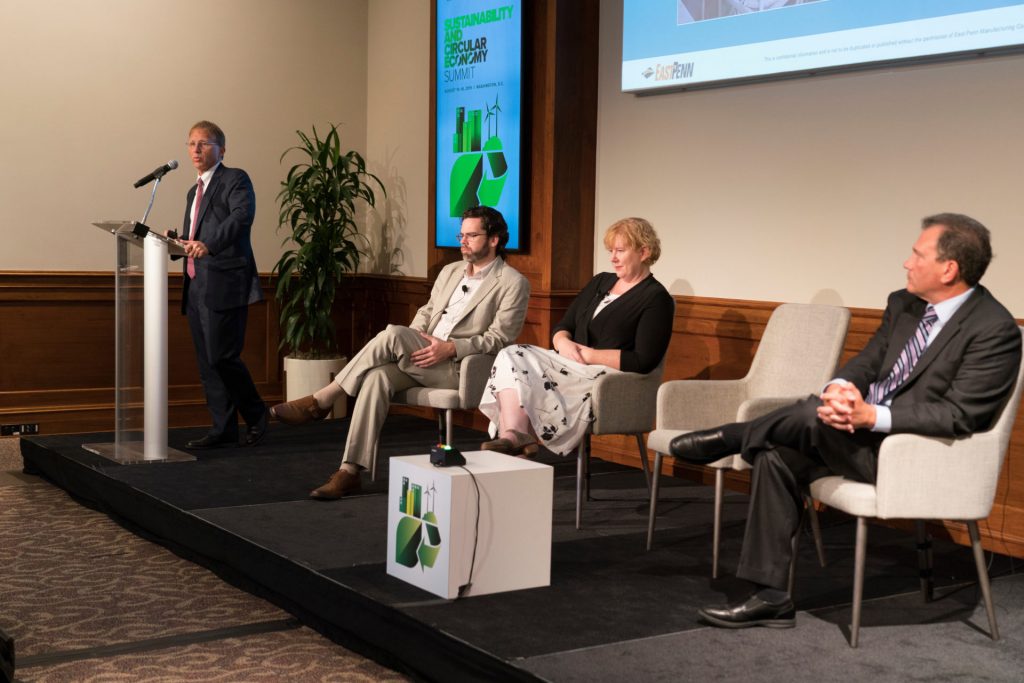 East Penn Manufacturing CEO/President Chris Pruitt, joined by Lawrence Bowdish, Chamber of Commerce Foundation; Dr. Carole Mars, The Sustainability Consortium; and Dr. Mark Drezdzon, RSR Technologies, explain the circular economy of lead batteries.
East Penn Manufacturing CEO/President Chris Pruitt, joined by Lawrence Bowdish, Chamber of Commerce Foundation; Dr. Carole Mars, The Sustainability Consortium; and Dr. Mark Drezdzon, RSR Technologies, explain the circular economy of lead batteries. Decision-Makers Gather at U.S. Chamber of Commerce Foundation Event to Share Sustainability Strategies Through 2030
WASHINGTON, August 15, 2019 – Today, leaders from the lead battery manufacturing and recycling industry shared its circular economy success with those attending the U.S. Chamber of Commerce Foundation’s 5th Annual Sustainability and Circular Economy Summit. Held in the nation’s capital, the two-day conference unites a cross-section of sustainability and circular economy professionals to educate one another on replicable, successful initiatives and benchmark strategies for impact through 2030 and beyond.
Highlighting this afternoon’s “Data for Good” session was discussion on the success of the lead battery industry’s circularity and commercial viability. Its closed-loop infrastructure results in a 99.3% recycling rate, use of 80% recycled materials, and “Most Recycled Consumer Product” recognition by the EPA.
During the session, Dr. Carole Mars, Director of Technical Development and Innovation for The Sustainability Consortium (TSC), spoke on making the lead battery industry a circular economy model for other sectors.
“Lead batteries close the loop more effectively than any other product in the consumer goods space,” Mars said. “We’d like to leverage the lessons of this industry to help others reach the same type of performance for their end-of-life products.” TSC’s mission is to help make consumer products worldwide more sustainable.
The circularity of a lead battery has global impact, as the demand grows for sustainable energy storage in the renewable energy, automotive and digital technology sectors. Wood Mackenzie’s Power & Renewables latest report projects that energy storage deployments will grow thirteen-fold over the next six years, concentrated in the U.S. and China. One goal of the U.S. lead battery industry is to ensure that environmental criteria of batteries be equal to, or greater than, performance and cost criteria when evaluating battery options.
Also participating in the “Data for Good” session were executives from East Penn Manufacturing and RSR Technologies. Their leaders explained the companys’ sustainable materials management.
“Lead batteries are designed from the outset to ensure recyclability,” said East Penn Manufacturing CEO/President Chris Pruitt. “At our Berks County Pennsylvania facility, we recycle nearly 30,000 lead batteries every day, and the materials are reused to make new batteries over and over again.” In the true spirit of a circular economy, new products are also created from the recycled materials. From the recovered sulfuric acid, East Penn annually sells 25,000 tons of liquid fertilizer solution as raw material to fertilizer manufacturers.
Dr. Mark Drezdzon is Vice President of Research and Development for RSR Technologies, a subsidiary of ECOBAT Technologies Ltd., one of the world’s largest producers and recyclers of lead. Drezdzon noted that performance advancements made in lead batteries over the past 20 years have not compromised the recyclability of the product.
“We continue to improve lead battery performance,” Drezdzon stated. “The industry is engaged in a project at the Department of Energy’s Argonne National Laboratory to do fundamental research using state-of-the-art analytical tools to study a 160-year-old technology.” Using Argonne’s Advanced Photon Source, a synchrotron which generates high energy X-rays capable of studying a lead battery as it operates in real time, DOE scientists are studying the structural and chemical changes in a lead battery during operation to foster further improvements in battery performance.
Learn More at Essential Energy Everyday
Essential Energy Everyday exists to increase awareness of the critical importance of lead batteries in powering our daily lives and future. It encourages continued investment in sustainable lead battery technology to store and provide energy on demand. Its initiative is supported by the two global trade associations that represent the lead battery and lead industries, Battery Council International and the International Lead Association.


